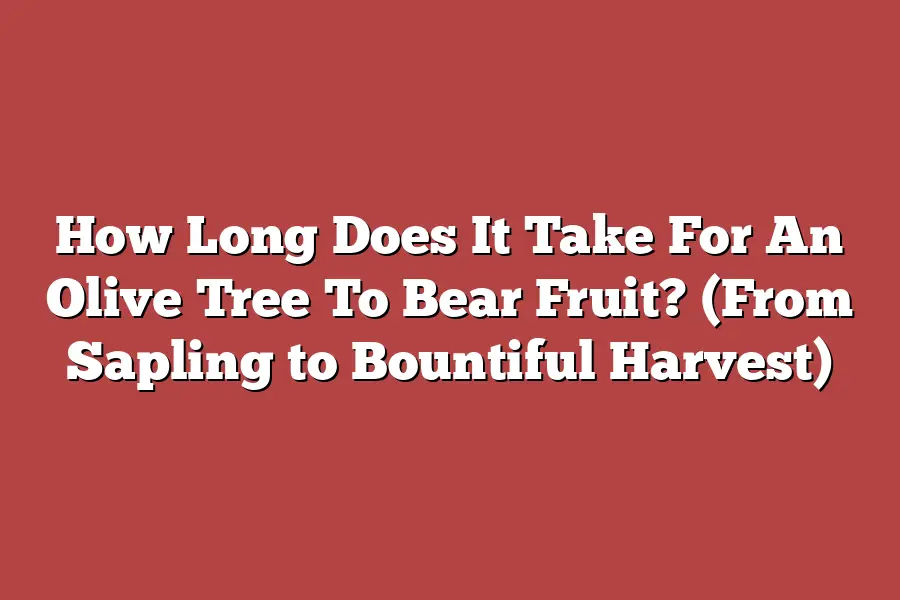Olive trees typically take around 3-5 years to start bearing fruit after planting, but it can take up to 10 years or more for a tree to reach its full production potential. Factors such as climate, soil quality, and proper care can affect the timing of an olive tree’s fruiting. With proper conditions, an olive tree can produce fruit continuously for many decades.
As I stood beneath the sprawling canopy of my prized olive tree, I couldn’t help but marvel at its majestic presence.
From humble sapling to mature behemoth, this tree had taught me valuable lessons about patience, perseverance, and the rewards that come from nurturing life.
As an olive enthusiast, I’ve spent countless hours studying the intricacies of these remarkable trees, and I’m excited to share my expertise with you.
In this journey through the growth stages of an olive tree, we’ll delve into the secrets of proper care, pruning, and pest management that will transform your sapling into a bountiful harvest-producing machine.
Whether you’re a seasoned olive farmer or a curious beginner, get ready to unlock the mysteries of these extraordinary trees and discover when you can expect a fruitful harvest.
Table of Contents
Understanding Olive Tree Growth Stages
As I stand amidst a lush olive grove, surrounded by towering trees bearing fruit in abundance, I’m reminded of the journey that brought them to this point.
From tiny saplings to bountiful harvests, the growth stages of an olive tree are nothing short of remarkable.
Germination: The Beginning of It All
It all starts with a small seed – literally!
Olive tree seeds, also known as pits, require the right conditions to germinate.
A warm and humid environment, around 65°F (18°C), is ideal for sparking new life.
With a bit of luck and some TLC, your sapling will emerge from its shell after about 6-12 months.
Seedling: Nurturing the New Life
Now that our little olive has poked its head out, it’s time to provide the right environment for growth.
This is the seedling stage, where careful attention ensures our young tree develops strong roots and a sturdy trunk.
It’s crucial to maintain consistent moisture levels and protect your sapling from harsh weather conditions.
Sapling: The Early Years
As your olive tree continues to grow, it enters the sapling phase – typically around 1-3 years old.
During this stage, it’s essential to prune regularly to encourage a strong structure and promote healthy growth.
This is also the time when pests and diseases can start to rear their ugly heads, making regular checks a must.
Young Adult: The Transition Phase
After about 5-10 years, your olive tree has reached young adulthood.
At this stage, it’s still learning to adapt to its environment and fine-tune its growth habits.
This is the perfect time to introduce training techniques, like pruning and staking, to help shape its future form.
Mature: The Fruiting Years
And then, after what feels like an eternity (but is actually around 10-20 years), your olive tree reaches maturity!
With proper care and attention throughout its growth stages, it’s now ready to bear fruit in abundance.
This is the culmination of all your hard work – a bountiful harvest that will keep you busy for months to come.
The Importance of Proper Care and Pruning
Throughout each stage of an olive tree’s life, proper care and pruning are crucial for optimal growth and fruiting.
Neglect or improper techniques can lead to stunted growth, reduced yields, or even the demise of your beloved tree.
In conclusion, the journey from sapling to bountiful harvest is a remarkable one – full of twists, turns, and tender loving care.
By understanding the different growth stages of an olive tree, you’ll be better equipped to provide the right conditions for your trees to thrive.
Happy growing!
Factors Affecting Fruit Production
When it comes to growing an olive tree, patience is a virtue.
It can take anywhere from 3-5 years for a sapling to start producing olives, and up to 10 years or more for the tree to reach its full potential.
But what exactly contributes to this delay?
As it turns out, several factors come into play that can either accelerate or hinder fruit production.
Climate: Dry vs. Humid Environments
Climate plays a significant role in determining how long it takes for an olive tree to bear fruit.
Trees grown in dry environments tend to produce earlier than those in humid areas.
This is because dry climates encourage the tree to focus its energy on producing fruit to compensate for the lack of water, whereas trees in humid environments can rely on consistent moisture levels.
For instance, olive trees cultivated in Mediterranean regions with hot summers and mild winters typically start producing olives within 3-4 years.
On the other hand, trees grown in cooler climates like Northern Europe or North America may take 5-7 years to reach fruiting maturity due to the more moderate temperatures and higher humidity.
Soil Quality: pH Levels and Nutrient Availability
Soil quality is another crucial factor that can impact olive tree health and productivity.
A tree planted in well-draining, nutrient-rich soil with a suitable pH level (olive trees prefer slightly alkaline conditions, between 6.5-8.5) will generally thrive and start producing fruit earlier than one grown in poor or hostile soil conditions.
Soil pH levels that are too high or too low can affect nutrient availability, making it difficult for the tree to access essential micronutrients like iron, calcium, and magnesium.
This can lead to stunted growth, reduced yields, or even prevent fruiting altogether.
Pest and Disease Management: Common Issues and Prevention
Lastly, pest and disease management are critical components of olive tree care that can significantly impact fruit production.
Common issues include:
- Aphids and other pests that feed on sap, causing stunted growth and reducing fruit yields
- Fungal diseases like powdery mildew, which can lead to defoliation and reduced photosynthesis
To prevent these problems, it’s essential to maintain good garden hygiene, monitor your trees regularly for signs of infestation or infection, and employ integrated pest management (IPM) strategies.
This might involve using organic pesticides, introducing beneficial insects, or practicing crop rotation.
By understanding and addressing these factors, you’ll be well on your way to cultivating a thriving olive tree that produces bountiful harvests for years to come.
When Can You Expect a Bountiful Harvest?
As an olive enthusiast, I’m sure you’re eager to know when your sapling will start yielding those luscious olives.
Well, buckle up, my friend, because the journey from sapling to bountiful harvest is a long but rewarding one.
On average, it takes around 5-10 years for an olive tree to start producing fruit after being planted as a sapling.
Now, I know what you’re thinking – that’s a looong time!
But trust me, the journey is worth it.
Think of all the tender loving care, pruning, and nurturing your tree will receive during those early years.
It’s like raising a child (but way more fun, because they don’t cry as much…
unless it’s when you forget to water them).
Now, let’s talk about what can speed up or slow down this process.
Proper Pruning is key!
When your tree is young, regular pruning helps shape its growth and encourages a strong root system.
It’s like giving your tree a haircut – gets rid of any dead ends (get it?) and keeps it looking fresh.
Regular watering and fertilization are also crucial.
I mean, who doesn’t love a good dose of sunshine and nutrients to help their tree thrive?
Just remember, too much of a good thing can be bad, so don’t overdo it!
Here’s the deal – maintaining a healthy and productive olive tree takes time, effort, and patience.
But if you stick with it, you’ll be rewarded with a bountiful harvest that’ll make your taste buds do the happy dance.
So, there you have it!
The lowdown on when to expect a bountiful harvest from your sapling.
Now go forth, nurture that tree, and reap those olives in no time!
Final Thoughts
As I reflect on the journey of an olive tree from sapling to bountiful harvest, I’m reminded that patience is a virtue – especially when it comes to nurturing these incredible trees.
It’s not just about providing the right conditions; it’s also about understanding the intricate dance between climate, soil, and pest management.
With proper care and attention, your olive tree will thrive, and you’ll be rewarded with a bounty of delicious fruit.
In my experience, the wait is well worth it – but it’s essential to stay committed to your trees’ needs throughout their growth stages.
Whether you’re a seasoned farmer or an enthusiastic gardener, I hope this post has provided valuable insights to help you cultivate a healthy and productive olive tree.
And when that first harvest finally arrives, I promise you’ll feel the same sense of pride and accomplishment that comes from watching something you’ve nurtured grow into its full potential.


